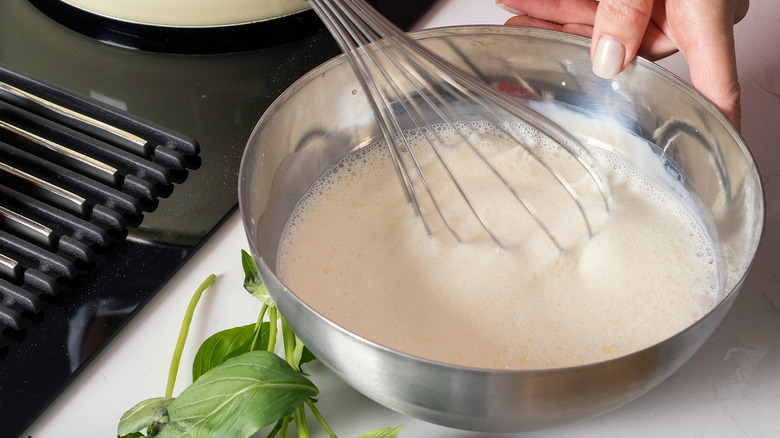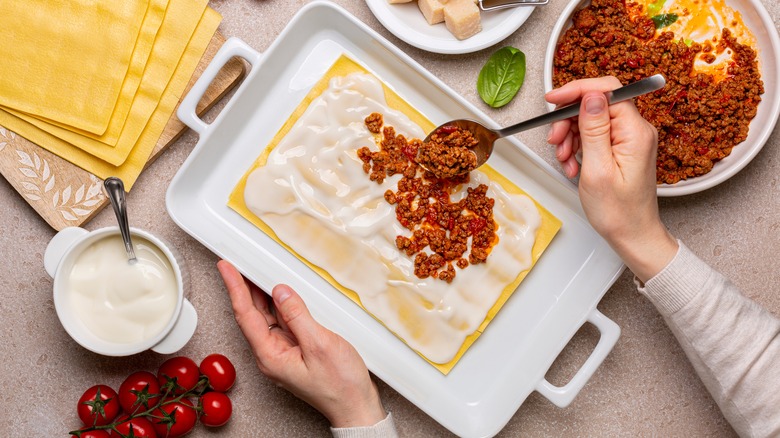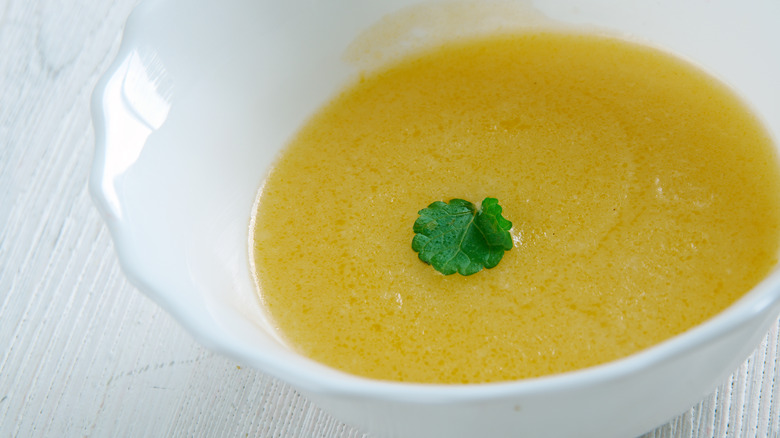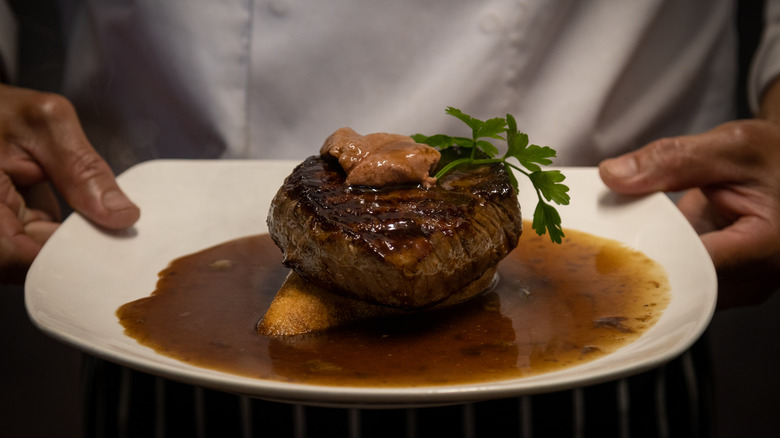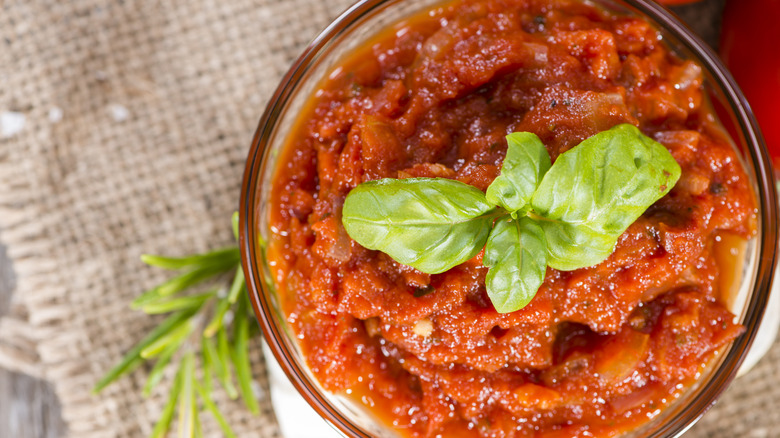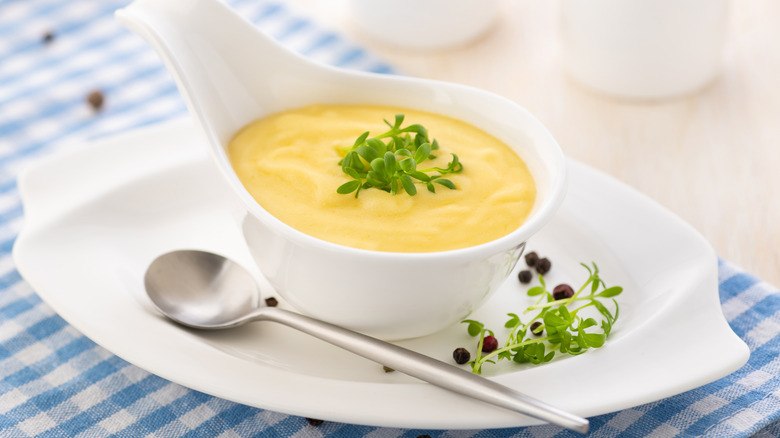French Cuisine's 5 Mother Sauces, Explained
Hundreds of sauces and a good number of soups begin as one of the five mother sauces of French cuisine. But it wasn't until the 19th century that anyone classified these sauces, per Le Foodist. That came about when a well-regarded French chef, Marie Antoine-Carême, took a stab at tracing what was essentially the "genealogy" of all the sauces he could think of. What he discovered is that most derive from four fundamental "mother" sauces.
In the early 20th century, another well-regarded French chef, Auguste Escoffier — who is now considered the father of "modern French cuisine," revisited his predecessor's rubric in his book Le Guide Culinaire. In the chapter "The Leading Sauces," he decided there were actually five, not four, mother sauces. These are béchamel, velouté, and espagnole, tomate, and hollandaise. Today, this list is widely accepted.
Each sauce is comprised of the same formula: a liquid, a thickener, and seasoning, per Unilever. In four of the mother sauces, the thickening agent is a roux. A classic roux consists of equal parts flour and butter stirred over medium-low heat for three to five minutes in the case of a light roux, for six to seven in the case of a brown roux, and up to 15 for a dark roux, according to Food Network (and yes, roux color matters). The other uses egg yolk as its thickening agent. But we'll get into all of that as we take a closer look at the five mother sauces of French cuisine.
Béchamel
Béchamel, which is also known as "white sauce," starts with the lightest color of roux and combines it with milk, according to Culinary Ambition. How much milk is needed depends upon how thick a béchamel is desired, and that can range from almost milky to something along the lines of homemade mayonnaise. Thinner béchamel can be used to coat meat or vegetables before breading. Thicker béchamel can be used to enrich lasagna, as shown above, or mac and cheese. It's also the foundation for the Mornay sauce that makes spinach Florentine so creamy and cheesy.
Given its neutral flavor profile, what béchamel adds to any dish that calls for it is a smooth, silky body. If béchamel were an actual mother, she'd be the strong but silent type, forming the backbone of her family while making it look like someone else deserves all the credit. On the other hand, béchamel has needs of its own, including your attention and some degree of patience.
Béchamel also makes a beloved stand-alone sauce for meats and vegetables. And if you're looking to elevate the flavor just a pinch, you can try this special method that will change your béchamel forever.
Velouté
The word velouté means velvet, which is a fairly apt description of this mother sauce's smooth and creamy texture. Slightly more flavorful than béchamel, it also begins with a three- to five-minute roux (e.g., a blonde or light roux made of flour and butter). However, whereas to make béchamel, you're mixing in milk, in making velouté, you're combining the roux with a clear or white stock, notes Escoffier Online.
Velouté's use of stock instead of milk delivers a slightly more complex flavor, but it can be further — and very easily — enhanced with lemon juice, wine, butter, a bit of cream, or even egg yolks. If you add both cream and egg yolks to a fish- or seafood-based velouté, it's called Sauce Normandy. If you add butter and egg yolks, it's called Sauce Vin Blanc, per MasterClass. Both of these pair well with seafood. A velouté sauce thickened with cream, egg yolk, and lemon juice is called an allemande (per Food University). Adding mushrooms, parsley, and lemon juice make it a poulette.
Velouté can also be used as a base for starting a soup, according to Campbell's Soup UK, which describes velouté soups as creamy and thick. If you're curious, you can try making one for yourself with our easy chilled asparagus vichyssoise.
Espagnole sauce
Like béchamel and velouté, sauce espagnole, begins with a roux. But to make espagnole (the name means Spanish), the roux is cooked for longer, making it a brown roux, per Food Network. Specifically, espagnole sauce consists of brown roux to which mirepoix (diced carrots, celery, and onion), pureed tomato, and a dark stock (e.g., beef) are added, according to Epicurious. This multi-layered mother sauce is often served with audaciously flavored beef and lamb dishes, as noted by Simply Recipes.
But mostly, espagnole is used as the foundation for a number of other sauces. These include Madeira sauce, bordelaise sauce, sauce Robert, and sauce Diane. Perhaps the simplest to prepare of all the espagnole-based sauces, demi-glace, involves adding red wine and more stock to espagnole sauce and then reducing it until it is thick enough to easily coat the back of a spoon, according to Food Network.
Sauce tomate or sauce tomat
If sauce tomato/sauce tomat sounds a lot like tomato sauce, it's because they're one and the same, according to Escoffier Online — except that if it's being referred to as "sauce tomat," then it's more likely being used in the context of French cuisine. But by no means are its uses constrained geographically. To wit, sauce tomat is often used in Italian, Creole, Portuguese, and Spanish cuisine. Saveur hypothesizes that sauce tomat may be the "mother" of a Senegalese dish, ndambé, which involves black-eyed peas stewed in a sauce made from reduced tomatoes, and the tomato-based gravy that's served over biscuits in the American South. If you're curious, you can try making it yourself as part of this recipe for cornmeal-crusted catfish with tomato gravy.
Like béchamel, velouté, and espagnole sauces, the classic tomato-based mother sauce begins with a roux. But unlike the other three, tomat can also be made without a roux, simply by reducing down pureed tomatoes flavored with vegetables, meat, and stock, according to EHL Group Insight. Moreover, unlike these other three, tomato sauce was not among the four original mother sauces. However, Food52 points out that it's probably the first mother sauce that you ever had an occasion to taste since tomato sauce is so ubiquitous among foods enjoyed by youngsters (e.g., spaghetti and meatballs and pizza).
Hollandaise
The one sauce that doesn't have its roots in roux is hollandaise. Hollandaise means "Dutch" sauce," and you may recognize it as the silky sauce that distinguishes ordinary poached eggs served atop a split English muffin from the beloved brunch standby, eggs Benedict. In the original classification of the mother sauces, Marie Antoine-Carême included allemande rather than hollandaise; however, Escoffier's list switches the two, considering allemande to be a derivative of velouté. Hollandaise is similar to allemande in that it uses egg and lemon juice, but it uses a base of emulsified egg rather than stock and roux.
It also happens to be the least forgiving of all the mother sauces because it comprises an emulsion. And an emulsion, itself, is a bit of a paradox in that it's a mixture of two liquids whose molecules are not capable of combining in the first place — except in the presence of agitation (via Britannica). Think oil and water or oil and vinegar. In hollandaise, the liquids are egg yolk and melted butter.
Generally speaking, emulsifying hollandaise requires energetic whisking, although it's fair game to use this easy hollandaise hack instead. But hack or no hack, learning to make hollandaise will open up lots of possibilities. To wit, some of the sauces derived from hollandaise are maltaise (which involves adding a reduction of orange juice and zest), mousseline (which involves adding whipped cream to hollandaise), and moutarde (which involves adding mustard), per Rouxbe Online Culinary School.
